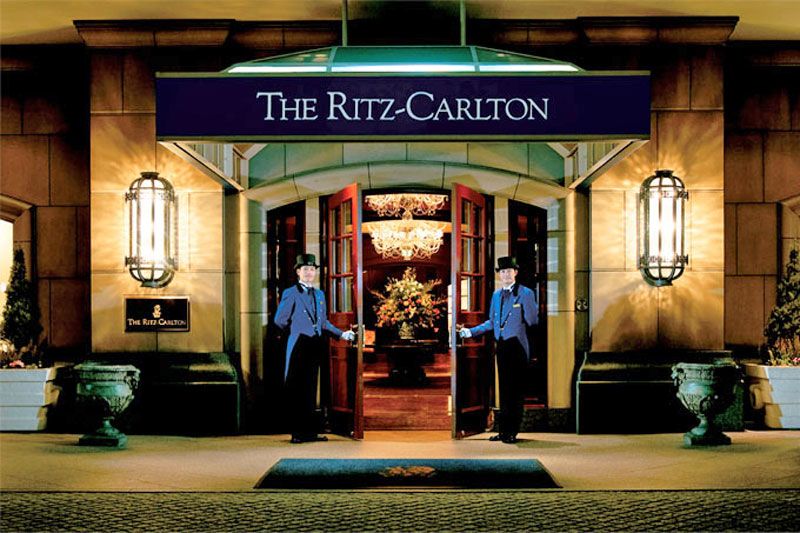
Ritz-Carlton is on an expansion blitz. By 2017, this global luxury hotel brand plans to open 15 new properties in Egypt, Tunisia, Morocco, Indonesia and Panama. In the last year and a half, eight diverse destinations now tout at least one Ritz-Carlton property: Japan, Israel, China, India, Kazakhstan, Aruba, Puerto Rico and Austria. I've long been a fan of the brand ever since my first stay at the brand’s Southern California's coastal haven The Ritz-Carlton, Laguna Niguel. Although excited to see the opening of the new modern properties, I remain preferential towards hotels with a bit of heritage and everlasting appeal. This is likely why The Ritz-Carlton in Japan's buzzing Osaka city resonated so well with me.

English 18th century art and grandeur were not what I expected to see in Japan, let alone at The Ritz-Carlton, Osaka. This property was the brand’s first Japanese hotel nearly two decades ago, and its classic colonial era art pieces somehow blend well with the timeless aesthetic Ritz-Carltons are known for. More than 450 18th-century style original works of art fill the 292-guestroom hotel. The global powerhouse interior design firm for many elite hotels, Hirsh Bedner Associates selected the art pieces and antiques which feature portraits and depict landscapes from German, English and Dutch artists. I asked the concierges if locals stroll through the property just to admire the hotel's remarkably vast art collection, and he admitted that handfuls a week do.
Calming and inviting, the art gives this Ritz property a warm appeal. “Collecting great art is synonymous with creating a truly gracious home-away-from-home,” noted Herve Humler, President and Chief Operating Officer of The Ritz-Carlton Hotel Company, L.L.C.

Rather unlike my home, however, are the six notable restaurants located within the hotel. The French restaurant La Baie and Chinese restaurant Xiang Tao, were both awarded a coveted Michelin star a few years ago and remain hallmarks of the dining scene in Osaka. In particular, the contemporary Le Baie is the only French restaurant in Osaka to hold a Michelin star. My favorite dining retreat within the hotel was Splendido, an Italian concept with a massive open kitchen. The Tuscany-like aura of the restaurant is ideal for Chef Christian Frigo’s fresh decadent pizzas and traditional dishes.

Although I have stayed at numerous Ritz-Carlton properties, I was unaware of the hotel group's significant community initiatives around the globe. Perhaps the brand deems constant promotion of such programs ostentatious or slight in comparison to its global expansion plans. Nonetheless, I feel compelled to mention just two of them here.

According to a recent NPR report, "Voluntourism" is one of the fastest growing tends in travel today. More than 1.6 million volunteer tourists now spend about $2 billion each year globally. The Ritz-Carlton has taken note. Guests of their resorts can now participate in the brand's Give Back Getaway programs which are half- and full-day volunteer experiences that place guests in the hotels' communities along with Ritz-Carlton staff. A quick scan of the remaining 2014 options show more than 80 opportunities to volunteer in the three areas of focus: Hunger and Poverty Relief, Environmental Conversation and Well-Being of Disadvantaged Children.

From saving sea turtles in Sanya, China to helping preserve natural historic sites in San Juan, Mexico, the Give Back Getaway options are impressively vast. (No opportunities are currently available in Osaka.) I have yet to find a hotel brand this extensively engaged in outreach that also invites guests along.

Related to the Give Back Getaways and equally admirable is the brand's recently launched Succeed Through Service initiative. In partnership with America’s Promise Alliance, a non-profit created by General Colin Powell, the program offers disadvantaged youth training with Ritz-Carlton staff both in classrooms and in the brand’s hotels. Business skills, such as having a firm handshake and dressing for professional settings, are lead by friendly and knowledgeable staff. Thus far, more than 15,000 students have benefited from this progressive program.









